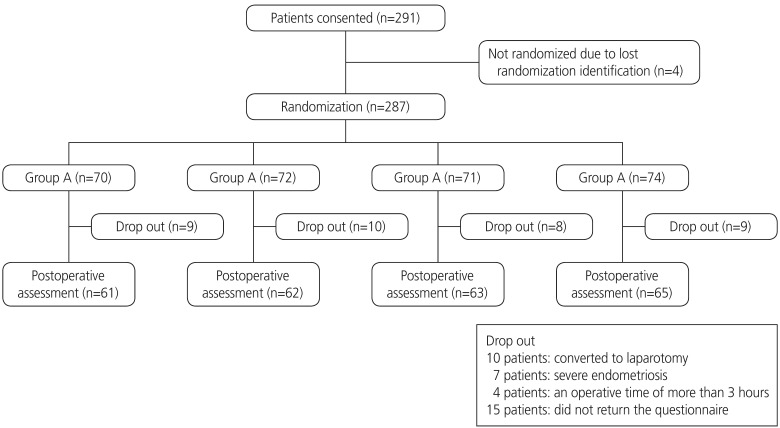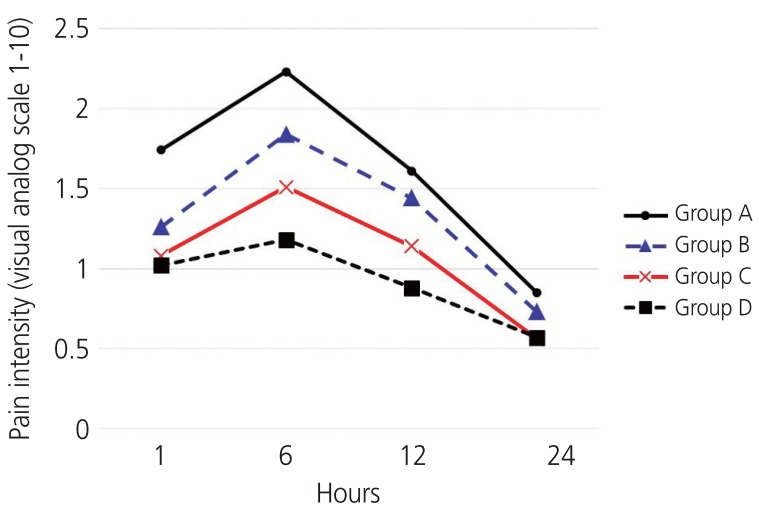Obstet Gynecol Sci.
2020 Mar;63(2):187-194. 10.5468/ogs.2020.63.2.187.
Combination of a pulmonary recruitment maneuver and intraperitoneal bupivacaine for the reduction of postoperative shoulder pain in gynecologic laparoscopy: a randomized, controlled trial
- Affiliations
-
- 1Department of Obstetrics and Gynecology, Samsung Medical Center, Sungkyunkwan University School of Medicine, Seoul, Korea. chelhun.choi@samsung.com
- 2Department of Obstetrics and Gynecology, College of Medicine, Konyang University, Daejeon, Korea.
- 3Department of Anesthesiology and Pain Medicine, Samsung Medical Center, Sungkyunkwan University School of Medicine, Seoul, Korea.
- KMID: 2471757
- DOI: http://doi.org/10.5468/ogs.2020.63.2.187
Abstract
OBJECTIVE
To compare the efficacy of a pulmonary recruitment maneuver using lower airway pressure (30 cm H2O) and intraperitoneal bupivacaine, alone or in combination, for reducing shoulder pain after gynecologic laparoscopy.
METHODS
A prospective controlled study was performed in a teaching hospital with patients who underwent elective gynecologic laparoscopic surgery. Two hundred eighty-seven patients were randomized into 1 of 4 groups: group A, placebo; group B, intraperitoneal instillation of bupivacaine; group C, CO2 removal by a pulmonary recruitment maneuver; group D, combination of intraperitoneal bupivacaine and pulmonary recruitment maneuver. The interventions were performed at the end of surgery. Shoulder pain was recorded on a visual analog scale (VAS) at 1, 6, 12, and 24 hours postoperatively.
RESULTS
The overall incidence of shoulder pain was 49.8% and the incidence tended to gradually decrease from group A to group D (59.0% in group A, 54.8% in group B, 44.4% in group C, and 41.5% in group D; P=0.026). In addition, the VAS scores gradually decreased from group A to D, although a statistically significant difference was only found at 6 hours postoperatively (P=0.03). There were no complications related to the interventions.
CONCLUSION
The combination of a pulmonary recruitment maneuver with intraperitoneal bupivacaine significantly reduced shoulder pain after gynecologic laparoscopy. TRIAL REGISTRATION: ClinicalTrials.gov Identifier: NCT01039441
Keyword
MeSH Terms
Figure
Reference
-
1. Grace PA, Quereshi A, Coleman J, Keane R, McEntee G, Broe P, et al. Reduced postoperative hospitalization after laparoscopic cholecystectomy. Br J Surg. 1991; 78:160–162. PMID: 1826624.
Article2. Ortega AE, Hunter JG, Peters JH, Swanstrom LL, Schirmer B. Laparoscopic Appendectomy Study Group. A prospective, randomized comparison of laparoscopic appendectomy with open appendectomy. Am J Surg. 1995; 169:208–212. PMID: 7840381.
Article4. Cason CL, Seidel SL, Bushmiaer M. Recovery from laparoscopic cholecystectomy procedures. AORN J. 1996; 63:1099–1103. PMID: 8771319.
Article5. Madsen MR, Jensen KE. Postoperative pain and nausea after laparoscopic cholecystectomy. Surg Laparosc Endosc. 1992; 2:303–305. PMID: 1341550.6. Tsai HW, Wang PH, Yen MS, Chao KC, Hsu TF, Chen YJ. Prevention of postlaparoscopic shoulder and upper abdominal pain: a randomized controlled trial. Obstet Gynecol. 2013; 121:526–531. PMID: 23635614.7. Ure BM, Troidl H, Spangenberger W, Dietrich A, Lefering R, Neugebauer E. Pain after laparoscopic cholecystectomy. Intensity and localization of pain and analysis of predictors in preoperative symptoms and intraoperative events. Surg Endosc. 1994; 8:90–96. PMID: 8165491.8. Lee DH, Song T, Kim KH, Lee KW. Incidence, natural course, and characteristics of postlaparoscopic shoulder pain. Surg Endosc. 2018; 32:160–165. PMID: 28643053.
Article9. Jackson SA, Laurence AS, Hill JC. Does post-laparoscopy pain relate to residual carbon dioxide? Anaesthesia. 1996; 51:485–487. PMID: 8694166.
Article10. Coventry DM. Anaesthesia for laparoscopic surgery. J R Coll Surg Edinb. 1995; 40:151–160. PMID: 7616466.11. Korell M, Schmaus F, Strowitzki T, Schneeweiss SG, Hepp H. Pain intensity following laparoscopy. Surg Laparosc Endosc. 1996; 6:375–379. PMID: 8890423.12. Song T, Kim KH, Lee KW. The intensity of postlaparoscopic shoulder pain is positively correlated with the amount of residual pneumoperitoneum. J Minim Invasive Gynecol. 2017; 24:984–989.e1. PMID: 28602786.
Article13. Labaille T, Mazoit JX, Paqueron X, Franco D, Benhamou D. The clinical efficacy and pharmacokinetics of intraperitoneal ropivacaine for laparoscopic cholecystectomy. Anesth Analg. 2002; 94:100–105. PMID: 11772809.
Article14. Lee IO, Kim SH, Kong MH, Lee MK, Kim NS, Choi YS, et al. Pain after laparoscopic cholecystectomy: the effect and timing of incisional and intraperitoneal bupivacaine. Can J Anaesth. 2001; 48:545–550. PMID: 11444448.
Article15. Narchi P, Benhamou D, Fernandez H. Intraperitoneal local anaesthetic for shoulder pain after day-case laparoscopy. Lancet. 1991; 338:1569–1570. PMID: 1683981.
Article16. Kelly MC. An assessment of the value of intraperitoneal bupivacaine for analgesia after laparoscopic sterilisation. Br J Obstet Gynaecol. 1996; 103:837–839. PMID: 8760719.17. Benhamou D, Narchi P, Mazoit JX, Fernandez H. Postoperative pain after local anesthetics for laparoscopic sterilization. Obstet Gynecol. 1994; 84:877–880. PMID: 7936530.18. Loughney AD, Sarma V, Ryall EA. Intraperitoneal bupivacaine for the relief of pain following day case laparoscopy. Br J Obstet Gynaecol. 1994; 101:449–451. PMID: 8018622.
Article19. Shaw IC, Stevens J, Krishnamurthy S. The influence of intraperitoneal bupivacaine on pain following major laparoscopic gynaecological procedures. Anaesthesia. 2001; 56:1041–1044. PMID: 11703235.
Article20. Kaloo P, Armstrong S, Kaloo C, Jordan V. Interventions to reduce shoulder pain following gynaecological laparoscopic procedures. Cochrane Database Syst Rev. 2019; CD011101. PMID: 30699235.
Article21. Phelps P, Cakmakkaya OS, Apfel CC, Radke OC. A simple clinical maneuver to reduce laparoscopy-induced shoulder pain: a randomized controlled trial. Obstet Gynecol. 2008; 111:1155–1160. PMID: 18448749.22. Mouton WG, Bessell JR, Otten KT, Maddern GJ. Pain after laparoscopy. Surg Endosc. 1999; 13:445–448. PMID: 10227938.
Article23. Fredman B, Jedeikin R, Olsfanger D, Flor P, Gruzman A. Residual pneumoperitoneum: a cause of postoperative pain after laparoscopic cholecystectomy. Anesth Analg. 1994; 79:152–154. PMID: 8010427.24. Alexander JI, Hull MG. Abdominal pain after laparoscopy: the value of a gas drain. Br J Obstet Gynaecol. 1987; 94:267–269. PMID: 2952161.
Article25. Abbott J, Hawe J, Srivastava P, Hunter D, Garry R. Intraperitoneal gas drain to reduce pain after laparoscopy: randomized masked trial. Obstet Gynecol. 2001; 98:97–100. PMID: 11430964.
Article26. Esmat ME, Elsebae MM, Nasr MM, Elsebaie SB. Combined low pressure pneumoperitoneum and intraperitoneal infusion of normal saline for reducing shoulder tip pain following laparoscopic cholecystectomy. World J Surg. 2006; 30:1969–1973. PMID: 17043939.
Article27. Nursal TZ, Yildirim S, Tarim A, Noyan T, Poyraz P, Tuna N, et al. Effect of drainage on postoperative nausea, vomiting, and pain after laparoscopic cholecystectomy. Langenbecks Arch Surg. 2003; 388:95–100. PMID: 12684804.
Article28. Palmes D, Röttgermann S, Classen C, Haier J, Horstmann R. Randomized clinical trial of the influence of intraperitoneal local anaesthesia on pain after laparoscopic surgery. Br J Surg. 2007; 94:824–832. PMID: 17571296.
Article29. Swift G, Healey M, Varol N, Maher P, Hill D. A prospective randomised double-blind placebo controlled trial to assess whether gas drains reduce shoulder pain following gynaecological laparoscopy. Aust N Z J Obstet Gynaecol. 2002; 42:267–270. PMID: 12230061.
Article30. Tsai HW, Chen YJ, Ho CM, Hseu SS, Chao KC, Tsai SK, et al. Maneuvers to decrease laparoscopy-induced shoulder and upper abdominal pain: a randomized controlled study. Arch Surg. 2011; 146:1360–1366. PMID: 22184293.31. Rettenmaier MA, Micha JP, Lopez KL, Wilcox AM, Goldstein BH. A prospective, observational trial assessing the efficacy of abdominal compression in reducing laparoscopic-induced shoulder pain. Surg Innov. 2017; 24:552–556. PMID: 28677420.
Article32. Pasqualucci A, de Angelis V, Contardo R, Colò F, Terrosu G, Donini A, et al. Preemptive analgesia: intraperitoneal local anesthetic in laparoscopic cholecystectomy. A randomized, double-blind, placebo-controlled study. Anesthesiology. 1996; 85:11–20. PMID: 8694355.33. Tsimoyiannis EC, Siakas P, Tassis A, Lekkas ET, Tzourou H, Kambili M. Intraperitoneal normal saline infusion for postoperative pain after laparoscopic cholecystectomy. World J Surg. 1998; 22:824–828. PMID: 9673554.
Article34. Tusman G, Böhm SH, Vazquez de Anda GF, do Campo JL, Lachmann B. ‘Alveolar recruitment strategy’ improves arterial oxygenation during general anaesthesia. Br J Anaesth. 1999; 82:8–13. PMID: 10325828.
Article35. Magnusson L, Tenling A, Lemoine R, Högman M, Tydén H, Hedenstierna G. The safety of one, or repeated, vital capacity maneuvers during general anesthesia. Anesth Analg. 2000; 91:702–707. PMID: 10960404.
Article36. Ricard JD. Barotrauma during mechanical ventilation: why aren’t we seeing any more? Intensive Care Med. 2004; 30:533–535. PMID: 14985954.
Article
- Full Text Links
- Actions
-
Cited
- CITED
-
- Close
- Share
- Similar articles
-
- Additional low-pressure pulmonary recruitment for reducing post-laparoscopic shoulder pain in gynecologic laparoscopy: a randomized controlled trial
- Effect of the pulmonary recruitment maneuver on pain after laparoscopic gynecological oncologic surgery: a prospective randomized trial
- The impact of magnesium sulfate as adjuvant to intrathecal bupivacaine on intra-operative surgeon satisfaction and postoperative analgesia during laparoscopic gynecological surgery: randomized clinical study
- A Comparison of Epidural Morphine-Bupivacaine with Intravenous Morphine-Ketorolac in Patient-Controlled Analgesia after Gynecologic Operation
- Intraperitoneal nebulization versus intraperitoneal instillation of ropivacaine for postoperative pain management following laparoscopic donor nephrectomy



